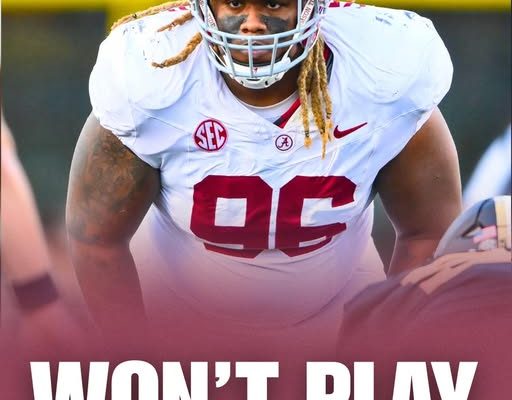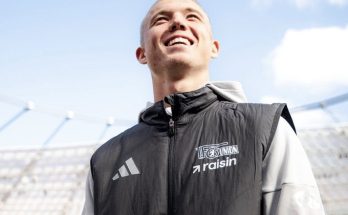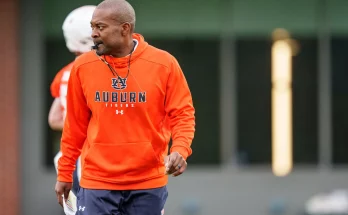WON’T PLAY: Alabama Captain Tim Keenan III Out vs. Florida State After Practice Injury
Alabama is heading into its biggest season opener in years without one of its most trusted defensive leaders. Defensive tackle and team captain Tim Keenan III will not suit up Saturday when the Crimson Tide faces Florida State in a high-stakes clash that already had massive implications. Now, Alabama’s defense is being thrown into a completely different kind of test.
Keenan, a 6-foot-2, 320-pound veteran, suffered an ankle injury during practice this week and has since been ruled out of the game. Reports indicate he’s expected to undergo tightrope surgery—a procedure designed to accelerate recovery from high-ankle sprains—but it still means Alabama will be without its starting nose tackle and one of its most experienced voices on the field for at least the next few weeks.
The visual alone—a dominant, dreadlocked Keenan lined up in full pads, now captioned with “WON’T PLAY” in bold white letters—tells the story plainly. It’s a blow. Not just schematically, but emotionally. Keenan’s presence in the middle of the defense was a known quantity. He was steady, physical, and had grown into a commanding communicator. His 2024 season numbers speak to that growth—40 tackles, 2.5 sacks, and a disruptive impact that didn’t always show up on the stat sheet but was felt every down.
This is not how Alabama wanted to start the Kalen DeBoer era.
With Keenan sidelined, the pressure immediately shifts to a trio of younger defensive linemen—James Smith, Jeremiah Beaman, and Edric Hill—who now find themselves at the center of the storm. There’s no easing into the lineup when your first major action comes against a Florida State team that returns experience on the offensive line, speed in the backfield, and a quarterback in Jordan Travis who can punish a defense that isn’t buttoned up. Keenan was the button.
But Alabama doesn’t deal in excuses, and neither does DeBoer. When asked about the injury and how the team would move forward, his response was short, clear, and direct: “New guys will have to step up.” That’s not spin. That’s the expectation. The standard doesn’t drop just because a captain is out. The Tide doesn’t lower the bar; they challenge someone else to reach it.
James Smith is likely the first man up. A former five-star recruit with a monster frame and explosive traits, Smith has been groomed as Keenan’s understudy. But raw power is only part of the job. The real test for Smith will be whether he can hold gaps against veteran blockers, communicate pre-snap with linebackers behind him, and play smart football under pressure. Physically, he looks the part. Mentally, Saturday will be the moment we find out.
Jeremiah Beaman brings a different element. He’s longer, leaner, and has been praised for his growth during the offseason. While still relatively untested, Beaman has flashed in practice, showing an ability to penetrate and create havoc in the backfield. If Alabama wants to get more aggressive in Keenan’s absence, Beaman might be a key part of that shift. But consistency has to come with the flash.
Then there’s Edric Hill—more compact, lighter on his feet, and capable of providing bursts of pressure in certain sets. While he doesn’t have the ideal size for anchoring against the run, Hill offers a change of pace and could be an effective rotational piece, particularly if the Tide wants to speed up its front four and try to flush Travis from the pocket.
None of these players have been in Keenan’s shoes before. Not just starting—starting in one of the most anticipated opening games in the country, with the national spotlight and playoff implications on the line. But that’s the nature of big-time football at Alabama. One guy goes down, three more get asked to be ready. It’s not always fair, but it’s always real.
This game was already going to be a measuring stick for Alabama. Now it’s a microscope. How well does DeBoer’s staff develop depth? How quickly can the younger guys respond to adversity? How does the defense adapt when the centerpiece is gone?
There’s also a leadership void to fill. Keenan wasn’t just clogging up the interior; he was the defensive communicator, the man teammates looked to when things needed to calm down or ramp up. His absence affects more than the line—it shakes the identity of the defense. Somebody has to be the one that players rally around when the game tightens and the stadium noise becomes deafening.
The next man up won’t just need to be physical. He’ll need to be vocal. That’s arguably the harder part. But it’s also the kind of pressure that reveals who’s ready and who still needs time.
While the immediate concern is Saturday night in Tallahassee, the bigger picture is Keenan’s recovery. Tightrope surgery has become more common in college football for high ankle sprains, and it’s designed to get players back on the field sooner than traditional methods. It uses a high-strength suture to stabilize the bones without restricting natural movement. The timeline varies, but depending on how the rehab goes, Keenan could return in four to six weeks—possibly in time for the heart of SEC play.
That’s the silver lining. This isn’t a season-ending injury. It’s a detour. And when Keenan does return, Alabama will ideally have a more experienced and battle-tested group behind him, thanks to this trial by fire. But that only happens if the young linemen don’t shrink from the moment. They need to lean into it.
This is also a huge coaching moment for DeBoer and his defensive staff. How do they adjust the game plan to protect the interior? Do they scheme more pressure from the edges to take heat off the middle? Do they rotate more aggressively to keep legs fresh and avoid breakdowns late in the game? Alabama has talent. It always does. But how that talent is deployed matters more than ever.
Saturday night is no warm-up. Florida State isn’t going to take it easy on Alabama because one of their captains is out. In fact, they’re more likely to test the middle early and often, knowing that the Crimson Tide will be relying on new faces to hold up. That puts enormous pressure on the entire defense to communicate, stay disciplined, and not let one injury snowball into something bigger.
There’s also the fan reaction to consider. Keenan is well-liked, respected, and viewed as one of the program’s anchors—so his absence stings, not just strategically, but emotionally. Seeing that “WON’T PLAY” image circulating around social media is a tough pill for fans, and it puts a spotlight on the program’s ability to adapt in real time.
But if there’s one constant with Alabama, it’s that the team doesn’t crumble when adversity hits. It recalibrates, regroups, and responds. This week has already felt like a playoff week in terms of preparation and focus. That only intensifies now.
Injuries happen. That’s football. But the best teams are the ones that don’t let injuries define them. They use them as fuel. Alabama still has the talent, still has the scheme, and still has the coaching to win this game. It just won’t be with its leader in the middle.
Instead, it will be with a young, hungry group that has everything to prove and one massive opportunity to do it. Keenan will be watching, likely coaching from the sideline as best he can. And when he returns, he’ll rejoin a defense that—if all goes well—has already grown stronger in his absence.
For now, the message is simple. Keenan won’t play. But Alabama still will.



